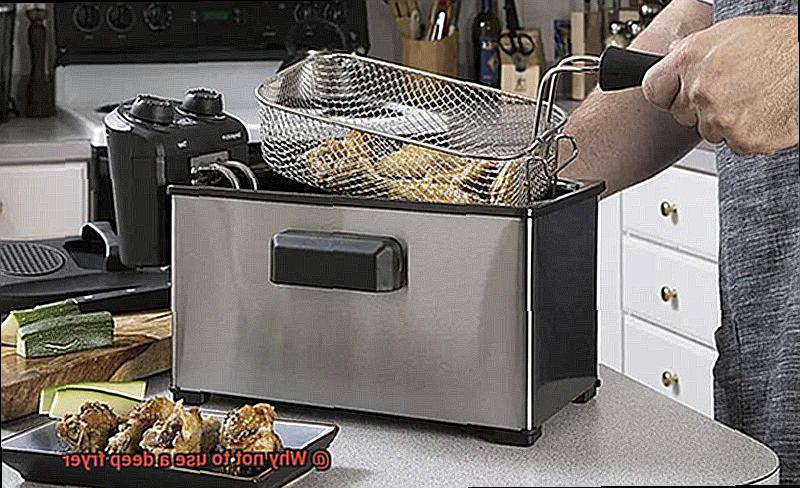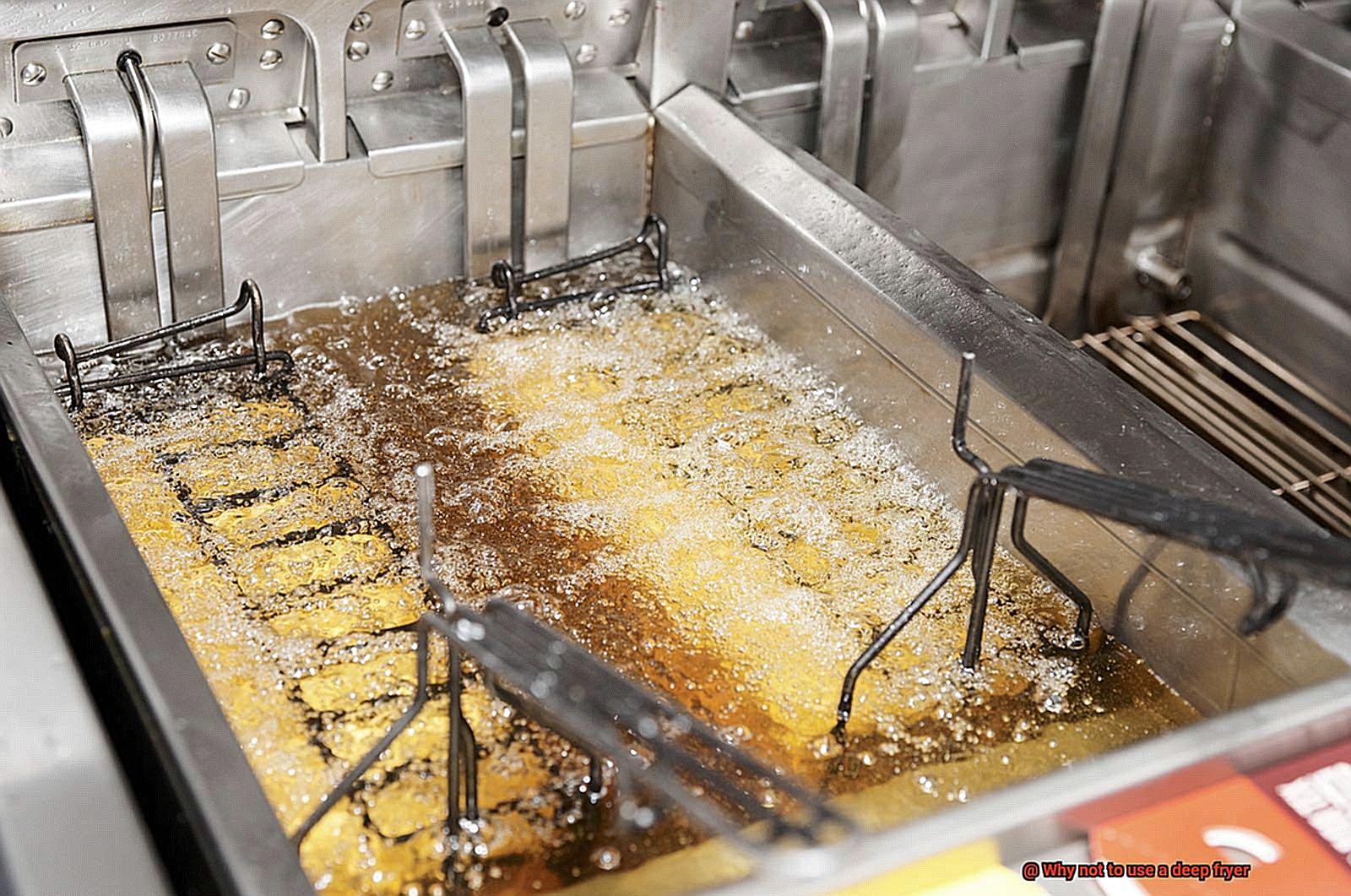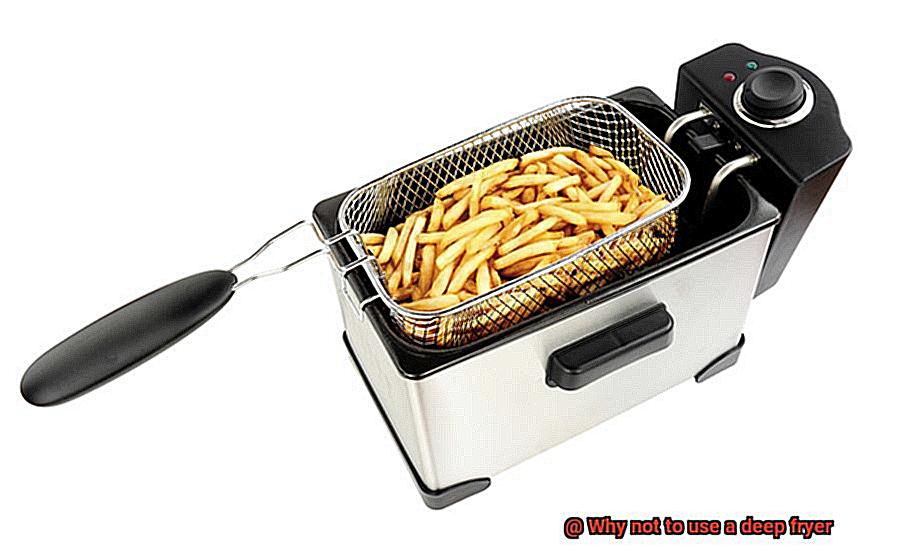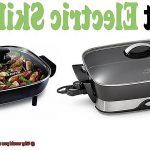Who can resist the crispy, golden goodness of fried food? But before you reach for that deep fryer, let me tell you about the dangers lurking inside. As an expert in this field, I’ve seen my fair share of injuries, illnesses, and even fires caused by these machines. So why not avoid the risks altogether? In this post, I’ll explain why you should steer clear of deep fryers and choose healthier cooking options instead.
Let’s start with the health risks. Deep frying produces acrylamide – a chemical compound that’s been linked to cancer – due to the high heat and chemical reactions involved. And it’s not just about acrylamide. Fried foods are packed with calories, saturated fats, and trans fats that can lead to heart disease, diabetes, and obesity.
But wait, there’s more. Deep fryers are also hazardous in other ways. They’re one of the leading causes of kitchen fires because hot oil spills and overheating are all too common. And if you’re not careful around hot oil and kitchen equipment, burns and injuries can happen in an instant.
So why take unnecessary risks when there are safer alternatives out there? Baking, grilling or air-frying your food can give you that same delicious taste without compromising your health or safety. Trust me when I say that avoiding deep fryers is a small price to pay for peace of mind – both for yourself and your loved ones.
Contents
What is a Deep Fryer?
If so, you may have considered adding a deep fryer to your kitchen arsenal. But what exactly is a deep fryer and what should you know before making the investment?
A deep fryer is a kitchen appliance designed to fry food items by submerging them in hot oil. The appliance consists of a fryer pot filled with oil that is heated to a high temperature, allowing the food to cook quickly while achieving that irresistible golden-brown exterior. Popular foods for frying include French fries, onion rings, and chicken nuggets.
However, before rushing out to purchase a deep fryer, there are some important considerations to keep in mind. Firstly, deep frying is not a healthy cooking method as it can lead to consuming unhealthy fats, calories, and sodium that can cause health problems such as heart disease, obesity, and high blood pressure. Additionally, the high temperatures involved in deep frying can lead to harmful chemicals forming that can be carcinogenic.
Secondly, deep frying can pose safety hazards if not used properly. Hot oil can cause severe burns if it spills or splatters. Moreover, deep fryers can ignite if the oil comes into contact with an open flame or sparks.

Lastly, using a deep fryer can be costly and time-consuming due to the large quantities of oil required and the need for regular oil changes. This can add up over time and create unnecessary waste.
Despite these potential drawbacks, many home cooks still opt for deep fryers due to their convenience and ability to create perfectly fried foods. If you do decide to invest in a deep fryer, ensure safe and effective use by following these tips:
- Read the manufacturer’s instructions carefully before using your deep fryer.
- Use caution when handling hot oil and never leave the fryer unattended while in use.
- Avoid overfilling the fryer or adding too much food at once.
- Use a thermometer to ensure that your oil is at the correct temperature for cooking.
- Dispose of used oil responsibly, following local guidelines for safe disposal.

Health Risks of Deep Frying
While they may be a delicious treat, it’s crucial to consider the potential health risks associated with this cooking technique. As an expert on the health risks of deep frying, I’ve compiled some research notes to help you make an informed decision about whether or not to add a deep fryer to your kitchen.
First off, the high calorie and fat content of deep-fried foods is a significant health concern. Foods cooked in hot oil are often loaded with calories, saturated fat, and trans fats that can contribute to obesity, heart disease, and other health problems. In fact, consuming too much fried food can even raise your risk of developing type 2 diabetes and certain types of cancer.
Another alarming factor is the production of acrylamide during the deep-frying process. This chemical forms when certain foods are cooked at high temperatures, like when they are deep-fried. While more research is needed to determine its effects on humans, acrylamide has been linked to an increased risk of cancer in animals.
Besides these internal health risks, there are also external dangers associated with deep frying. Burns and injuries from hot oil are common when dealing with this cooking method. The high temperature of the oil can cause severe burns if it splatters or spills onto skin. Additionally, deep-frying equipment can be hazardous if not used properly, such as when it overheats or malfunctions.
To minimize these risks, it’s essential to be mindful of how frequently you consume fried foods and opt for healthier cooking methods like baking or grilling instead. If you do choose to indulge in some deep-fried goodness, be sure to handle hot oil with extreme caution and follow all safety guidelines for your deep-frying equipment.
Potential Dangers of Using a Deep Fryer
As tempting as it may be to indulge in crispy fried chicken or golden french fries, it’s important to consider the potential dangers of using a deep fryer. As an expert on this topic, I cannot emphasize enough the importance of being aware of the risks involved.
One of the most significant dangers of using a deep fryer is the risk of burns from hot oil. The oil in a deep fryer can reach scorching temperatures of up to 400 degrees Fahrenheit, which can easily cause serious burns if it comes into contact with skin. It is vital to handle hot oil with caution and ensure that the deep fryer is positioned on a stable surface away from any flammable materials.
But that’s not all – fire is another potential danger that comes with using a deep fryer. When oil is heated to high temperatures, it can quickly ignite and cause a fire, especially if left unattended or if the fryer is not cleaned properly. A fire caused by a deep fryer can be devastating, so it’s important to keep a close eye on it at all times and clean it thoroughly after every use.
In addition to burns and fires, consuming fried foods regularly can also lead to health problems. Fried foods are often high in calories and fat, which can contribute to obesity, heart disease, and other health issues. In fact, eating fried foods regularly has been linked to an increased risk of type 2 diabetes.
Messy and Time-Consuming Process
While the crispy, golden goodness may be tempting, it’s important to consider the potential drawbacks of this cooking method. As an expert on the messy and time-consuming process of using a deep fryer, let me share some insight with you.
First off, prep work is no joke. You have to heat up your oil and get it to the correct temperature – not a speedy process. Plus, you need to be careful to avoid getting burned by hot oil splatters. Safety first.
Once your oil is hot enough, it’s time to lower your food into the fryer without making a mess. This can be especially challenging if you’re working with larger or irregularly-shaped items. Overloading the fryer can also result in soggy, greasy food – not exactly what we’re going for here.
After your food is finished frying, you then have to remove it from the fryer and let it drain on paper towels or a wire rack. While this step is essential for getting rid of excess oil, it can also be messy and time-consuming – especially if you’re frying up a large batch.
Cleaning up after using a deep fryer can also be a hassle. Disposing of used oil safely and thoroughly cleaning your fryer can take quite a bit of effort and time – unless you want to deal with leftover bits of food or funky smells.
Alternatives to Deep Frying
As much as we all love the indulgent taste of deep-fried food, we also know that it comes with a hefty price – added health risks. But fret not, foodies. There are many alternatives to deep frying that can still give you that same delicious taste without the guilt.
Firstly, there’s baking – a classic method of cooking that involves no oil at all. Whether you’re craving chicken wings or sweet potato fries, baking your food in the oven can give it a crispy texture, while keeping the calorie and fat count low.
If you’re looking for a more adventurous option, grilling is the way to go. Whether you opt for an indoor grill or an outdoor barbecue, grilling your food can give it a unique smoky flavor that’s hard to replicate with other cooking methods. The best part? It allows the fat to drip away from your food instead of being absorbed into it, making it a healthier option.
For those who prefer quick and easy meals, sautéing or stir-frying are great options that require only a small amount of oil and minimal prep time. Sautéing involves cooking your food in a pan with a little oil, while stir-frying requires high heat and constant stirring in a wok. Either way, you’ll end up with a delicious meal that’s easy on the waistline.
Last but not least, there’s the air fryer – a revolutionary gadget that uses hot air to cook your food instead of oil. This method results in a much healthier meal and gives your food that coveted crispy texture similar to deep frying. From chicken wings to French fries and even vegetables, an air fryer can do it all.
Benefits of Grilling vs. Deep Frying
Look no further than grilling. As an expert on the topic, I have compiled some research notes to explain the numerous benefits of grilling compared to deep frying.
First and foremost, grilling is a low-fat cooking method that doesn’t require adding excess oils or fats. This means that grilled foods are generally lower in calories and fat compared to deep-fried foods. When you grill your food, the fats naturally present in it will melt away, leaving you with a healthier and leaner meal. Plus, who doesn’t love those perfect grill marks?
But that’s not all. Grilling also helps retain the nutritional value of food. By locking in essential vitamins and minerals, your meals remain packed with nutrition. On the other hand, deep frying can cause a significant loss of nutrients as the high temperatures and prolonged cooking time can damage the nutritional content of food.
Moreover, grilling is a versatile cooking method that can be used for a wide range of foods. From vegetables and fruits to meats and seafood, there’s nothing that can’t be grilled to perfection. Grilled foods also tend to have a unique smoky flavor that cannot be achieved through deep frying.
On the other hand, deep frying involves submerging food in hot oil, which means it absorbs large amounts of oil during cooking. This can result in foods that are high in unhealthy fats and calories, which can contribute to weight gain and other health problems such as heart disease.

It’s important to note that deep-fried foods can also contain harmful substances such as acrylamide, which is a carcinogenic substance formed when starchy foods are fried at high temperatures. This can increase the risk of cancer and other health problems.
Tips for Safely Using a Deep Fryer
Deep fryers can be a great addition to your kitchen, but it’s important to prioritize safety when using them. Here are 5 key tips to keep in mind:
Read the manual thoroughly
Every deep fryer is different, so it’s crucial to read the manual before using it. The manual will provide you with essential details about how to safely operate your specific appliance, including recommended oil levels and cooking temperatures.
Choose the right oil
Not all oils are suitable for deep frying. It’s best to choose an oil with a high smoke point, such as canola or peanut oil, to prevent the oil from overheating and potentially causing a fire.
Don’t overfill the fryer
Overfilling your deep fryer with oil can cause it to overflow and potentially start a fire. Make sure to only use the recommended amount of oil for your appliance.
Keep children and pets away
Deep fryers can be extremely dangerous for children and pets, so it’s important to keep them away from the appliance while it’s in use. Hot oil can cause severe burns if it spills, so never leave your deep fryer unattended.
Use protective gear
When handling hot oil or removing food from the fryer, always wear protective gear such as oven mitts and safety goggles. This will help shield you from burns and splatters.
6Zuz3EySdH8″ >
Conclusion
In summary, it’s crucial to steer clear of using a deep fryer for cooking. The health risks linked with consuming fried foods are alarmingly high. From heart disease, diabetes, obesity to even cancer due to the formation of acrylamide, the dangers are real. Moreover, deep fryers pose safety hazards such as burns and fires caused by hot oil spills or overheating.
Thankfully, there are healthier and safer alternatives to deep frying. Baking, grilling, air-frying, sautéing or stir-frying can give you that same mouth-watering taste without compromising your health or safety. Grilling is particularly beneficial as it is a low-fat cooking method that retains the nutritional value of food while providing a unique smoky flavor.
If you still choose to use a deep fryer despite its potential hazards, please follow safety guidelines carefully. Read the manufacturer’s instructions thoroughly before use and always handle hot oil with caution. Use protective gear and keep children and pets away from the appliance while it’s in use.
Ultimately, avoiding deep fryers is a small price to pay for peace of mind – both for yourself and your loved ones.






